|
|
|
Sort Order |
|
|
|
Items / Page
|
|
|
|
|
|
|
| Srl | Item |
| 1 |
ID:
164396
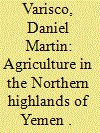

|
|
|
|
|
| Summary/Abstract |
The most fertile part of the Arabian Peninsula is the southwestern corner known historically as Yemen. The primary occupation of Yemen’s tribes over the centuries has been sedentary agriculture, stemming back to the pre-Islamic South Arabian kingdoms. Up until the revolution that toppled the Zaydī imamate in 1962, agricultural activities had change little over the centuries. After the revolution and civil war in the north, development aid poured into Yemen and access became available to modern machinery, especially diesel pumps for wells, and supplies. This article analyzes the transition from a household subsistence-based production to cash cropping in the northern highlands of Yemen. The focus is on the regions north and east of the capital Ṣanʿāʾ, which received less aid than the coastal region and southern highlands. Details are provided on the methods and production of agricultural crops in the period between 1975 and 1985, with an assessment of the potential future development of agriculture in a country currently torn apart by war.
|
|
|
|
|
|
|
|
|
|
|
|
|
|
|
|
| 2 |
ID:
164399
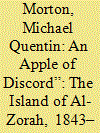

|
|
|
|
|
| Summary/Abstract |
Based on an extensive study of archival records, this article shows how a series of episodes in the history of the Trucial Coast — today’s United Arab Emirates (UAE) — helped to shape the direction of the area’s history. At face value, the island of al-Zorah appeared to have little to offer, but it nevertheless figured in the ambitions of the Wahhābīs, local rulers and the British, all of whom coveted it for one reason or another; the outcome of their struggles helped to set the seal on the future configuration of the UAE. While the article provides a valuable insight into Great Britain’s role in the area, it also reveals regional rivalries and inter-tribal tensions that still exist in the region today. However, the coming together of the UAE and Saudi Arabia, and their need to show solidarity in the face of current challenges, have obscured the historical differences that the story of al-Zorah represents.
|
|
|
|
|
|
|
|
|
|
|
|
|
|
|
|
| 3 |
ID:
164397
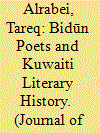

|
|
|
|
|
| Summary/Abstract |
This article examines the ways in which Bidūn (stateless) poets negotiate and contest their placement within dominant narratives of national literary history in Kuwait. The article offers an analytical overview of the dominant modalities in which national literary history in Kuwait has been conceived as it relates to questions of national beginnings, periodization and the placement of stateless poets. Read against the existing modalities, the article analyzes the Bidūn poet Saʿdiyya Mufarriḥ’s The Cameleers of Clouds and Estrangement (2007) as a revisionist account of national literary history that opposes the exclusion of Bidūn writers. This is achieved by an emphasis on the inclusivity of literary and cultural affiliation over the exclusivity of limiting notions of official national belonging. A critical analysis of the arena of national literary history writing in Kuwait aims to offer a novel perspective on how notions of national belonging are being renegotiated from the margins.
|
|
|
|
|
|
|
|
|
|
|
|
|
|
|
|
| 4 |
ID:
164398
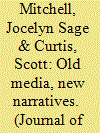

|
|
|
|
|
| Summary/Abstract |
In 1959, a Danish anthropological expedition to Qatar created hundreds of photographs and a 16-minute film depicting the diversity of Qatari lifestyles, which included strong evidence of a Bedouin past, separate from the merchant and pearl-diving culture of the coast. However, Qatar’s new national museum, still under development, has been working on a different narrative: a more unified national identity that emphasizes the similarities of Qatari heritage rather than the differences. Artifacts such as these photos and film can become inconvenient when they do not fit new and improved civic myths, yet as some of the most important (and well known) surviving images of Qatar’s heritage, this evidence cannot be left out. How might the museum make use of the evidence so that it aligns with its narrative? Here we focus on the aesthetic style of Jette Bang’s photographs and film, which emphasizes the warmth, hospitality, and universal humanity of Qatari heritage. Our argument connects the historical and ideological contexts for both the new national museum’s push for a unity narrative and Bang’s 1959 photographs and film. We suggest that the artistic elements of these ostensibly scientific and historical artifacts may offer Qatar’s new museum a way to repurpose them without jeopardizing a narrative of national unity.
|
|
|
|
|
|
|
|
|
|
|
|
|
|
|
|
| 5 |
ID:
164400
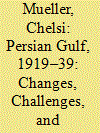

|
|
|
|
|
| Summary/Abstract |
The interwar period (1919–39) was a formative period in the Persian Gulf. These years marked a transition from a Gulf society once characterized by symbiosis and interdependency to a sub-region characterized by national divisions, sectarian suspicions, rivalries and political tension. This period witnessed a surge of anti-colonial and nationalist feeling in Iran, the rise of a stridently nationalist military leader in the person of Reza Shah Pahlavi, his implementation of an assertive Persian Gulf policy and his re-assertion of Iran’s claims to coastal territories ruled by Arab shaykhs under British protection. The challenge posed by ascendant Iran to Britain’s dominant position in the Persian Gulf generated an abrupt shift from indirect to direct forms of colonial penetration in the Gulf Arab shaykhdoms and a transfer of Britain’s locus of power from the Iranian to the Arabian littoral. This article surveys the wide-ranging political, economic and social processes that transformed the Persian Gulf community into a sub-region of Arab-Iranian rivalry during the interwar period.
|
|
|
|
|
|
|
|
|
|
|
|
|
|
|
|
| 6 |
ID:
164401
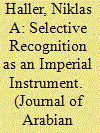

|
|
|
|
|
| Summary/Abstract |
Pursuing political objectives, Western imperial powers were selective in the inclusion of non-European polities into the realm of sovereign states. In the case of the Trucial States –– the contemporary United Arab Emirates –– Britain as the imperial power granted recognition to a regularly changing number of local shaykhdoms through the negotiation and repeated exchange of treaties, with important repercussions for the later political and urban development of the country. This article examines Britain’s decision-making regarding these recognitions from 1820–1952. Building on British archival records, it argues that the final result of seven recognized sovereign emirates was only to a very limited degree a representation of the situation as it existed on the ground. Instead it was largely the outcome of a British policy of selective recognition, driven by the strategic rationale of obtaining accountable and coercible treaty partners, and by tactical considerations such as the exclusion of imperial competitors, the erection of bases, and the obtainment of oil concessions.
|
|
|
|
|
|
|
|
|
|
|
|
|
|
|
|
| 7 |
ID:
164402


|
|
|
|
|
| Summary/Abstract |
This paper sheds some light on the new landscape of digital feminist activism in Saudi Arabia, which has been rarely analyzed using the lens of social movements theories. I specifically focus on the Twitter campaign to end the male guardianship system, in which a growing number of Saudi women have reclaimed the use of Twitter to disseminate their claims and demand social reforms, maneuvering by that a constraining political environment that is characterized by a dearth of channels for civic engagement, lack of traditional forms of feminist organizing, and different calculations for mobilization, and in this way the women’s movement does resemble a state of abeyance. Consequently, the paper presents new evidence that challenges the traditional take on abeyance by emphasizing on how Twitter can be used as a catalyst for the emergence and preservation of ad-hoc abeyance networks that enables and sustains the feminist movement activities.
|
|
|
|
|
|
|
|
|
|
|
|
|
|
|
|
|
|
|
|
|